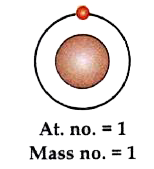Isotopes have same number of atomic mass
To determine whether the statement "Isotopes have the same number of atomic mass" is true or false, we need to understand the definitions and characteristics of isotopes.
1. Definition of Isotopes:
- Isotopes are variants of a particular chemical element that have the same number of protons but different numbers of neutrons. This means they have the same atomic number (Z) but different mass numbers (A).
2. Understanding Atomic Number and Mass Number:
- The atomic number (Z) is the number of protons in the nucleus of an atom, which defines the element.
- The mass number (A) is the total number of protons and neutrons in the nucleus. Since isotopes have the same number of protons but different numbers of neutrons, their mass numbers will differ.
3. Example of Isotopes:
- Consider the isotopes of chlorine: Chlorine-35 (Cl-35) and Chlorine-37 (Cl-37).
- Both isotopes have an atomic number of 17 (indicating they both have 17 protons and 17 electrons).
- However, Cl-35 has 18 neutrons (35 - 17 = 18), and Cl-37 has 20 neutrons (37 - 17 = 20).
4. Conclusion:
- Since isotopes have the same atomic number but different mass numbers, the statement "Isotopes have the same number of atomic mass" is false.
Final Answer:
The statement is false.
---
- Isotopes are variants of a particular chemical element that have the same number of protons but different numbers of neutrons. This means they have the same atomic number (Z) but different mass numbers (A).
- The atomic number (Z) is the number of protons in the nucleus of an atom, which defines the element.
- The mass number (A) is the total number of protons and neutrons in the nucleus. Since isotopes have the same number of protons but different numbers of neutrons, their mass numbers will differ.
- Consider the isotopes of chlorine: Chlorine-35 (Cl-35) and Chlorine-37 (Cl-37).
- Both isotopes have an atomic number of 17 (indicating they both have 17 protons and 17 electrons).
- However, Cl-35 has 18 neutrons (35 - 17 = 18), and Cl-37 has 20 neutrons (37 - 17 = 20).
- Since isotopes have the same atomic number but different mass numbers, the statement "Isotopes have the same number of atomic mass" is false.
The statement is false.
Topper's Solved these Questions
- ATOMIC STRUCTUREBook:CENGAGE CHEMISTRY ENGLISHChapter:ATOMIC STRUCTUREExercise:Archives (Linked Comprehension
Explore 3 Videos
- ATOMIC STRUCTUREBook:CENGAGE CHEMISTRY ENGLISHChapter:ATOMIC STRUCTUREExercise:Archives Multiple Correct
Explore 7 Videos
- ATOMIC STRUCTUREBook:CENGAGE CHEMISTRY ENGLISHChapter:ATOMIC STRUCTUREExercise:Exercises Fill In The Balnks
Explore 56 Videos
- APPENDIX - INORGANIC VOLUME 1Book:CENGAGE CHEMISTRY ENGLISHChapter:APPENDIX - INORGANIC VOLUME 1Exercise:chapter-7 Single correct answer
Explore 1 Video
- CHEMICAL BONDING AND MOLECULAR STRUCTUREBook:CENGAGE CHEMISTRY ENGLISHChapter:CHEMICAL BONDING AND MOLECULAR STRUCTUREExercise:Archives Subjective
Explore 15 Videos
Similar Questions
Knowledge Check
Compounds having the same number of atoms of the same
elements but differ only in the arrangement of the atoms are
called :AisobarsBisostersChomomersDisomersAssertion : All the isotopes of a given element show same chemical behaviour.
Reason : Isotopes have different number of neutrons present in the nucleus.AIf both assertion and reason are true and reason is the correct explanation of assertion.BIf both assertion and reason are true but reason is not the correct explanation of assertion.CIf assertion is true but reason is false.DIf both assertion and reason are false.
Acids and ester having the same number of carbon atoms are:
View SolutionWhat mass of Ca will have the same number of atoms as in 3.2 g of S ?
View SolutionAssertion: bcc and ccp have same packing efficiency
Reason: Both have same number of atoms per unit cell and same arrangement
View SolutionThe diagram represents an isotope of hydrogen (H). Answer the following:
Do isotopes have the same atomic number or the same mass number.

View SolutionA sample of sodium has a mass of 46g. What is the mass of the same number of calcium atoms as sodium atoms present in given sample ?
View SolutionName the following:
Two atoms having the same number of protons and electrons but different number of neutrons.
View Solution